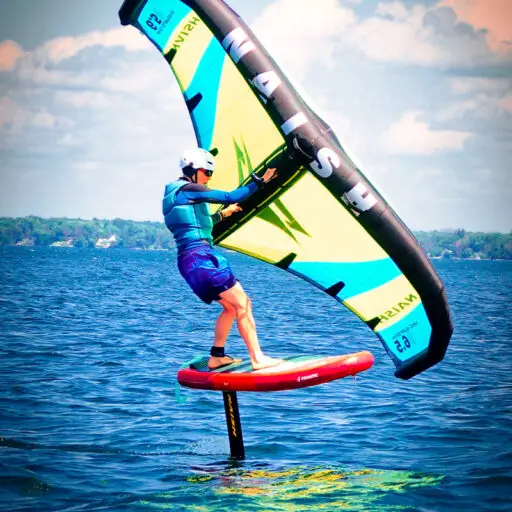Support our hydrofoil educational content for free when you purchase through links on our site. Learn more
[2023] What is the Purpose of a Hydrofoil? All You Need to Know About Hydrofoiling™
Are you curious about hydrofoils and their purpose? Look no further! At Hydrofoiling™, we’re all about hydrofoil boarding, and we’re here to provide you with expert advice and information. In this article, we’ll dive deep into the purpose of hydrofoils, how they work, their benefits, and how to choose the right one for your needs. So, let’s get started!
Table of Contents
- Quick Answer
- Quick Tips and Facts
- Background
- How Does a Hydrofoil Work?
- Benefits of Using a Hydrofoil
- Choosing the Right Hydrofoil
- FAQ
- Conclusion
- Recommended Links
- Reference Links
Quick Answer
A hydrofoil is a wing-like structure that is attached to a boat or surfboard to lift it out of the water, reducing drag and increasing speed and efficiency. Hydrofoils work by generating lift as water flows over and under the foil, allowing the vessel to glide smoothly above the water’s surface. They are commonly used in various water sports, including surfing, sailing, and powerboating.
Shop Hydrofoils on: Amazon | Walmart | Etsy
Quick Tips and Facts
- Hydrofoils are commonly used in water sports such as surfing, sailing, and powerboating.
- They lift the boat or surfboard out of the water, reducing drag and increasing speed.
- Hydrofoils work by generating lift as water flows over and under the foil.
- They can improve stability, maneuverability, and fuel efficiency.
- Choosing the right hydrofoil depends on factors such as boat type, size, and desired performance.
Background
Hydrofoils have been around for many years and have evolved into a popular technology in the world of water sports. The concept of using foils to lift boats out of the water dates back to the early 20th century, with notable advancements made in the 1950s and 1960s. Today, hydrofoils are widely used in various water sports disciplines, including surfing, sailing, and powerboating.
How Does a Hydrofoil Work?
Hydrofoils work on the principle of lift, similar to how an airplane wing generates lift to keep the aircraft airborne. When a hydrofoil is submerged in water and the boat or surfboard moves forward, water flows over and under the foil. This flow of water creates a pressure difference, with higher pressure below the foil and lower pressure above it. This pressure difference generates lift, lifting the boat or surfboard out of the water.
The lift generated by the hydrofoil reduces the amount of hull surface area in contact with the water, resulting in reduced drag. This reduction in drag allows the vessel to glide more efficiently through the water, increasing speed and performance. The hydrofoil also improves stability and maneuverability by providing additional lift and control.
Benefits of Using a Hydrofoil
Using a hydrofoil can offer several benefits for water sports enthusiasts. Here are some of the key advantages:
-
Increased Speed: Hydrofoils can significantly increase the speed of a boat or surfboard by reducing drag and allowing the vessel to glide above the water’s surface.
-
Improved Stability: The lift generated by the hydrofoil provides additional stability, making it easier to maintain balance and control while riding waves or maneuvering through the water.
-
Enhanced Maneuverability: Hydrofoils allow for sharper turns and more precise control, enhancing the overall maneuverability of the boat or surfboard.
-
Reduced Fuel Consumption: By reducing drag and increasing efficiency, hydrofoils can help reduce fuel consumption, making them an environmentally friendly choice.
-
Better Wave Riding: Hydrofoils can enhance the surfing experience by allowing riders to catch waves earlier and ride them for longer distances.
-
Versatility: Hydrofoils can be used in various water sports disciplines, including surfing, sailing, and powerboating, making them a versatile choice for water sports enthusiasts.
Choosing the Right Hydrofoil
When choosing a hydrofoil, there are several factors to consider to ensure you select the right one for your needs. Here are some key considerations:
-
Boat Type: Different hydrofoils are designed for specific boat types, such as powerboats, sailboats, or pontoon boats. Consider the type of boat you have and choose a hydrofoil that is compatible with your vessel.
-
Size and Weight: The size and weight of your boat will impact the effectiveness of the hydrofoil. Choose a hydrofoil that is suitable for the specifications of your boat to ensure optimal performance.
-
Foil Design: Hydrofoils come in various shapes and sizes, each offering different performance characteristics. Consider the design of the foil and choose one that aligns with your desired performance goals.
-
Material and Construction: Hydrofoils are typically made from materials such as aluminum or composite. Consider the material and construction quality to ensure durability and longevity.
-
Additional Features: Some hydrofoils may have additional features that enhance stability, control, or ease of installation. Consider any additional features that may be important to you.
FAQ

What is the function of a hydrofoil?
The function of a hydrofoil is to lift a boat or surfboard out of the water, reducing drag and increasing speed and efficiency. By generating lift as water flows over and under the foil, hydrofoils allow the vessel to glide smoothly above the water’s surface.
Read more about “… Are Hydrofoils Safe? A Comprehensive Guide to Hydrofoil Boarding Safety”
Is it worth putting a hydrofoil on a boat?
Putting a hydrofoil on a boat can be worth it, especially if you are looking to improve speed, stability, and fuel efficiency. Hydrofoils can significantly enhance the performance of a boat by reducing drag and increasing lift, resulting in a smoother and more efficient ride.
Will a hydrofoil make my boat faster?
Yes, a hydrofoil can make your boat faster by reducing drag and allowing the vessel to glide above the water’s surface. The lift generated by the hydrofoil helps to increase speed and performance, resulting in a faster and more efficient ride.
Why do boats not use hydrofoils?
While hydrofoils offer many benefits, not all boats use them due to various reasons. Some boats may not require the additional speed or performance enhancement provided by hydrofoils. Additionally, the cost and complexity of installing and maintaining hydrofoils may deter some boat owners from using them.
Read more about “Why do boats not use hydrofoils?”
Conclusion
In conclusion, hydrofoils serve the purpose of lifting boats and surfboards out of the water, reducing drag, and increasing speed and efficiency. They offer numerous benefits, including increased speed, improved stability, enhanced maneuverability, and reduced fuel consumption. When choosing a hydrofoil, consider factors such as boat type, size, foil design, material, and additional features. By selecting the right hydrofoil for your needs, you can enhance your water sports experience and enjoy the thrill of gliding above the water’s surface.
Shop Hydrofoils on: Amazon | Walmart | Etsy
Recommended Links
- Hydrofoil Basics
- Hydrofoil History
- Advanced Hydrofoiling Techniques
- Hydrofoil Equipment Reviews
- 2023 Soviet Hydrofoil: All You Need to Know About Voskhod Hydrofoil Boats



